High-Fidelity Inhomogeneous Ground Clutter Simulation of Airborne Phased Array PD Radar Aided by Digital Elevation Model and Digital Land Classification Data
Abstract
:1. Introduction
2. Ground Clutter Modeling Aided by Geographic Information
2.1. DEM Data Information Extraction and Processing
2.1.1. DEM Data Information Extraction
2.1.2. Shield Processing
- If and , then the surface scattering point at low elevation is shielded by the surface scattering point at high altitude, and the surface scattering point cannot be irradiated by the radar (i.e., the point is not visible to the radar), this situation is the sight-shield;
- If the angle between the normal vector of the plane where the surface scattering point is located and the sight vector is greater than 90° (i.e., is less than 0°), this situation is self-shield.
2.2. Matching and Calculation of Backscattering Coefficient Model Based on DLCD
2.2.1. Backscattering Coefficient Calculation of Water Surface Landform
2.2.2. Backscattering Coefficients Calculation of Different Land Surface Natural Landforms
2.2.3. Backscattering Coefficient Calculation of Urban Landform
2.3. Ground Clutter Simulation of Airborne Phased Array PD Radar Based on Ward Model
3. Simulation Flow
- Step 1.
- Step 2.
- Calculate the elevation value, the slant range, azimuth, pitch angle, and grazing angle of each surface scattering point relative to the aircraft from DEM data;
- Step 3.
- Shield processing according to the grazing angle and slant range, and remove surface scattering points that do not contribute to the radar echo;
- Step 4.
- Read the land surface classification codes of the surface scattering points, determine the types of different landforms and match different backscattering coefficient models;
- Step 5.
- Calculate the backscattering coefficients of the scattering points at various locations within the radar range and use Ward model to realize high-fidelity inhomogeneous ground clutter simulation.
4. Simulation Results Analysis and Discussion
4.1. Simulation Condition Description
4.2. Simulation Results
5. Conclusions
Author Contributions
Funding
Conflicts of Interest
References
- Zhang, L.; Xu, Y.G. Prospect for Technology of Airborne Early Warning Radar. Mod. Radar 2015, 1, 1–7. [Google Scholar]
- Dudczyk, J. A method of feature selection in the aspect of specific identification of radar signals. Bull. Pol. Acad. Sci.-Tech. Sci. 2017, 65, 113–119. [Google Scholar] [CrossRef] [Green Version]
- Dudczyk, J. Radar Emission Sources Identification Based on Hierarchical Agglomerative Clustering for Large Data Sets. J. Sens. 2016, 2016. [Google Scholar] [CrossRef]
- Piedrow, D.; Matuszewski, J. Object Detection and Recognition System Using Artificial Neural Networks and Drones. J. Electr. Eng. 2018, 6, 46–51. [Google Scholar]
- Matuszewski, J.; Paradowski, L. The knowledge based approach for emitter identification. In Proceedings of the International Conference on Microwaves and Radar, Krakow, Poland, 20–22 May 1998. [Google Scholar]
- Matuszewski, J. The radar signature in recognition system database. In Proceedings of the International Conference on Microwave Radar and Wireless Communications, Warsaw, Poland, 21–23 May 2012. [Google Scholar]
- Fan, X.K.; Qu, Y. An overview of knowledge-aided clutter mitigation methods for airborne radar. Chin. J. Electron. 2012, 40, 1199–1206. [Google Scholar]
- Guerci, J.R.; Baranoski, E.J. Knowledge-aided adaptive radar at DARPA: An overview. IEEE Signal Process. Mag. 2006, 23, 41–50. [Google Scholar] [CrossRef]
- Wang, A.G. Terrain Clutter Modeling and Simulation for Airborne Radar System Based on Digital Elevation Model. Master’s Thesis, University of Electronic Science and Technology of China, Chengdu, China, 2013. [Google Scholar]
- Fan, G.Z.; Yang, Z.L.; Jin, L. Clutter Simulation for Airborne Pulse-Doppler Radar Based on Natural Ground Scene. Mod. Radar 2007, 29, 5–7. [Google Scholar]
- Hellard, D.L.; Henry, J.P.; Agnesina, E.; Moruzzis, M. Ground clutter simulation for surface-based radars. In Proceedings of the IEEE International Radar Conference, Alexandria, VA, USA, 8–11 May 1995. [Google Scholar]
- Kurekin, A.; Radford, D.; Lever, K.; Marshall, D. New method for generating site-specific clutter map for land-based radar by using multimodal remote-sensing images and digital terrain data. IET Radar Sonar Navig. 2011, 5, 374–388. [Google Scholar] [CrossRef]
- Rao, N.N.; Chen, X.B.; Zhou, J.B.; Qiu, Z.Y.; Liu, D.Y. Research on Ground Clutter Modeling of Airborne Cognitive Radar Based on Digital Elevation Model Data. J. Univ. Electron. Sci. Technol. China 2016, 45, 511–519. [Google Scholar]
- Zhou, M. Detection of Low-Altitude Wind Shear Based on Knowledge. Master’s Thesis, Civil Aviation University of China, Tianjin, China, 2016. [Google Scholar]
- Hong, L.N. Research on Radar Land Clutter Modeling and Simulation. Master’s Thesis, National University of Defense Technology, Changsha, China, 2003. [Google Scholar]
- Su, Y.D.; Lu, M.; Zang, W. Simulation and Analysis of the Sea Surface Backscattering Coefficient for Radio Fuze. J. Ordnance Equip. Eng. 2017, 38, 52–55. [Google Scholar]
- Peng, S.R.; Tang, Z.Y. Reflectivity Model of Ground/Sea Clutter. J. Airforce Radar Acad. 2000, 14, 1–4. [Google Scholar]
- Ulaby, F.T.; Moore, R.K.; Fung, A.K. Microwave Remote Sensing Volume II: Radar Remote Sensing and Surface Scattering and Emission Theory; Huang, P.K.; Wang, Y.F., Translators; Science Press: Beijing, China, 1987. [Google Scholar]
- Feng, S.; Chen, J.; Zhang, J.; Tu, X.Y. Reflectivity Model of Low Grazing Angle Radar Land Clutter. Fire Control Command Control 2005, 30, 18–20. [Google Scholar]
- Ward, J. Space-Time Adaptive Processing for Airborne Radar; MIT Technical Report 1015; MIT Lincoln Laboratory: Lexington, MA, USA, 1994; pp. 20–24. [Google Scholar]
- Wang, Y.L.; Peng, Y.N. Space-Time Adaptive Signal Processing; Tsinghua University Press: Beijing, China, 2000; pp. 29–33. [Google Scholar]
- Tachikawa, T.; Hato, M.; Kaku, M.; Iwasaki, A. Characteristics of ASTER GDEM version 2. In Proceedings of the IEEE International Geoscience and Remote Sensing Symposium, Vancouver, BC, Canada, 24–29 July 2011. [Google Scholar]
- Capraro, C.T.; Bradaric, I.; Weiner, D.D. Implementing digital terrain data in knowledge-aided space-time adaptive processing. IEEE Trans. Aerosp. Electron. Syst. 2006, 42, 1080–1099. [Google Scholar] [CrossRef]

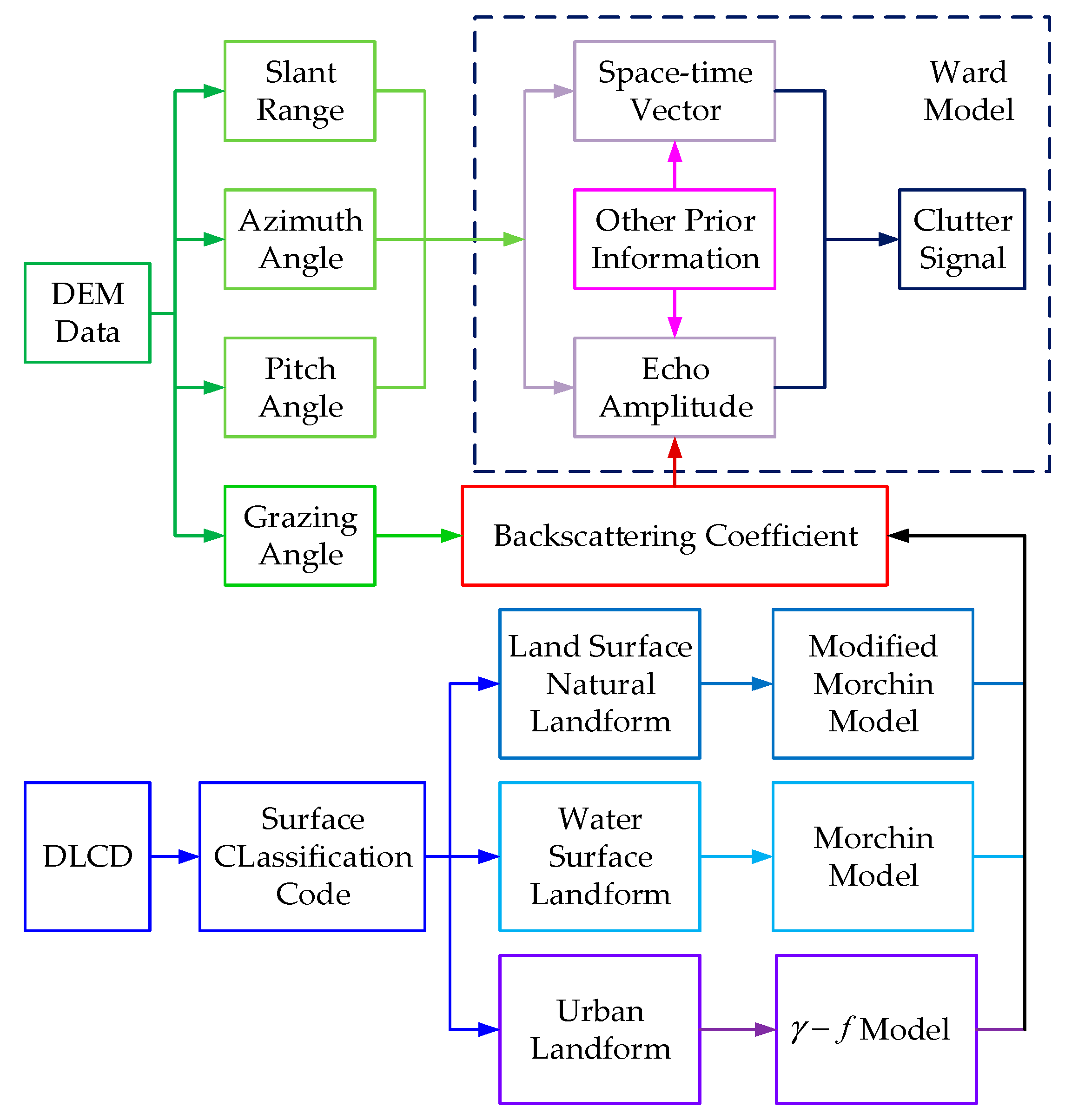


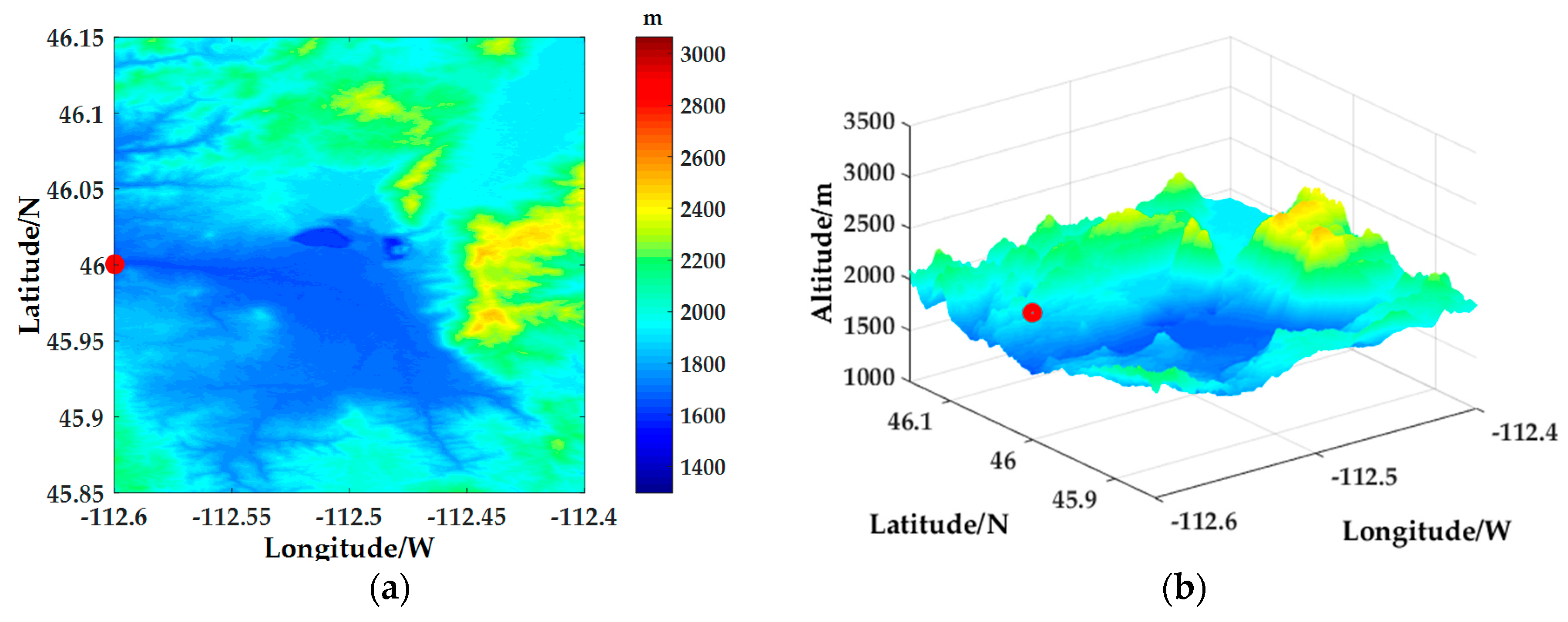
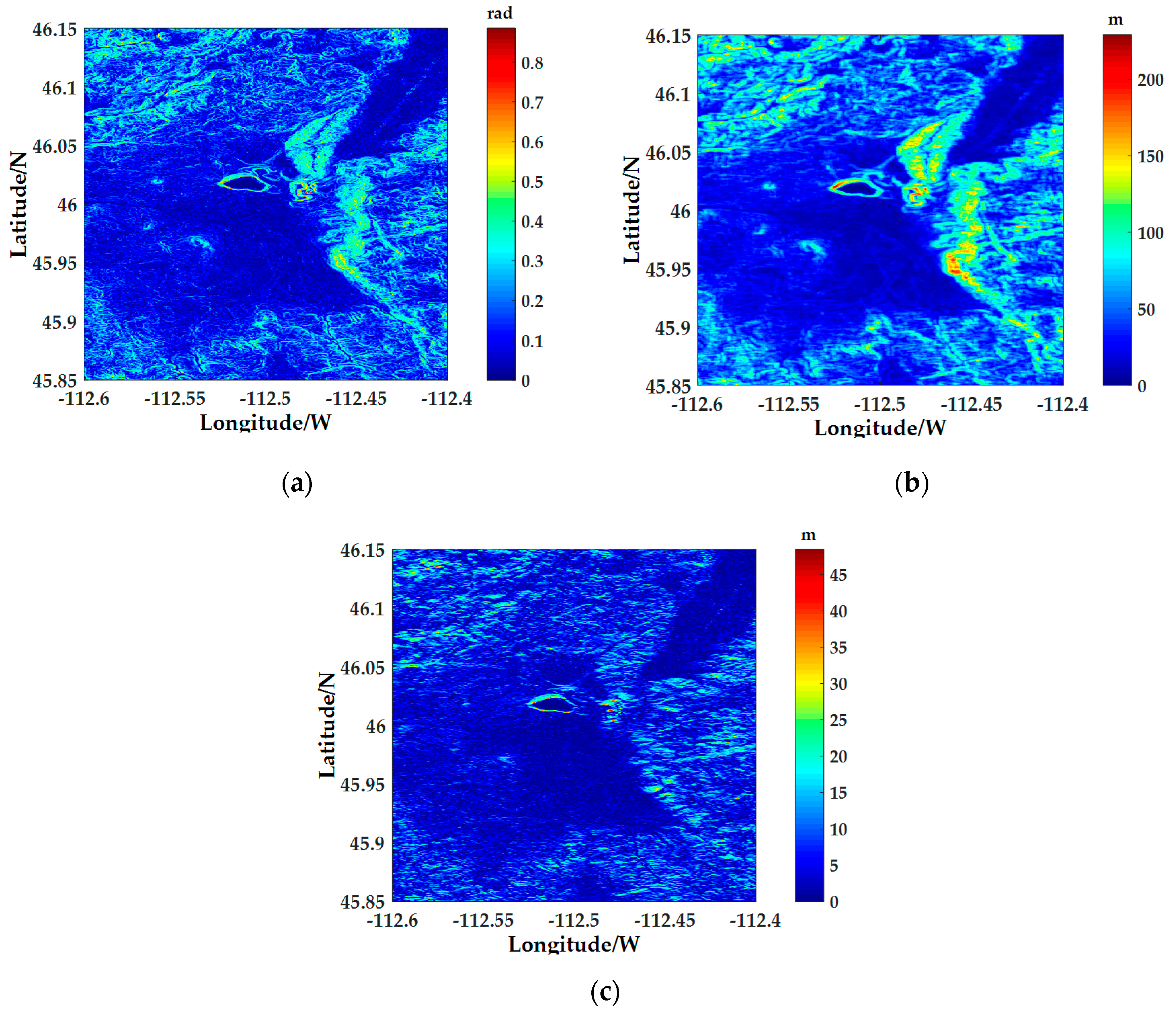
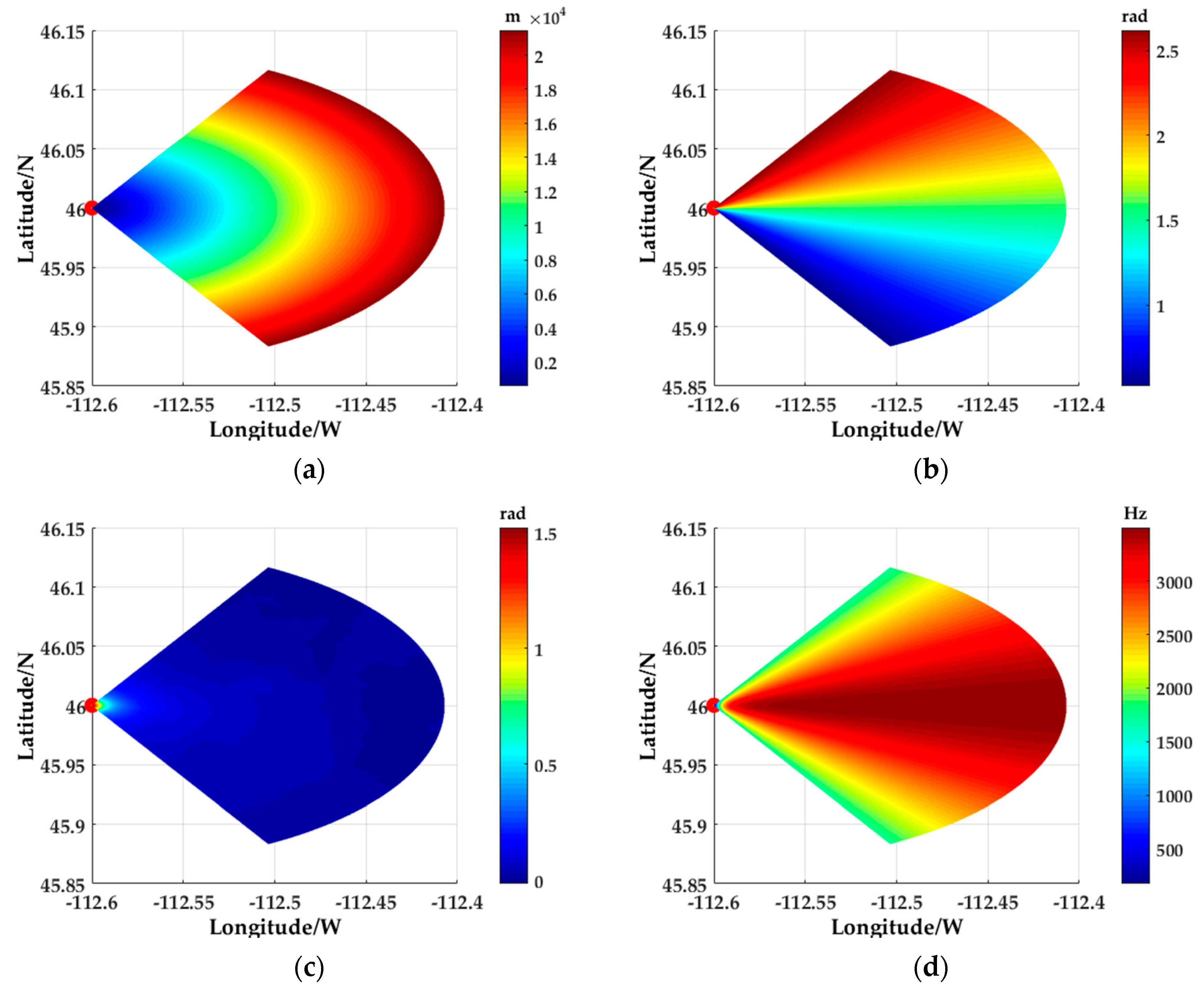
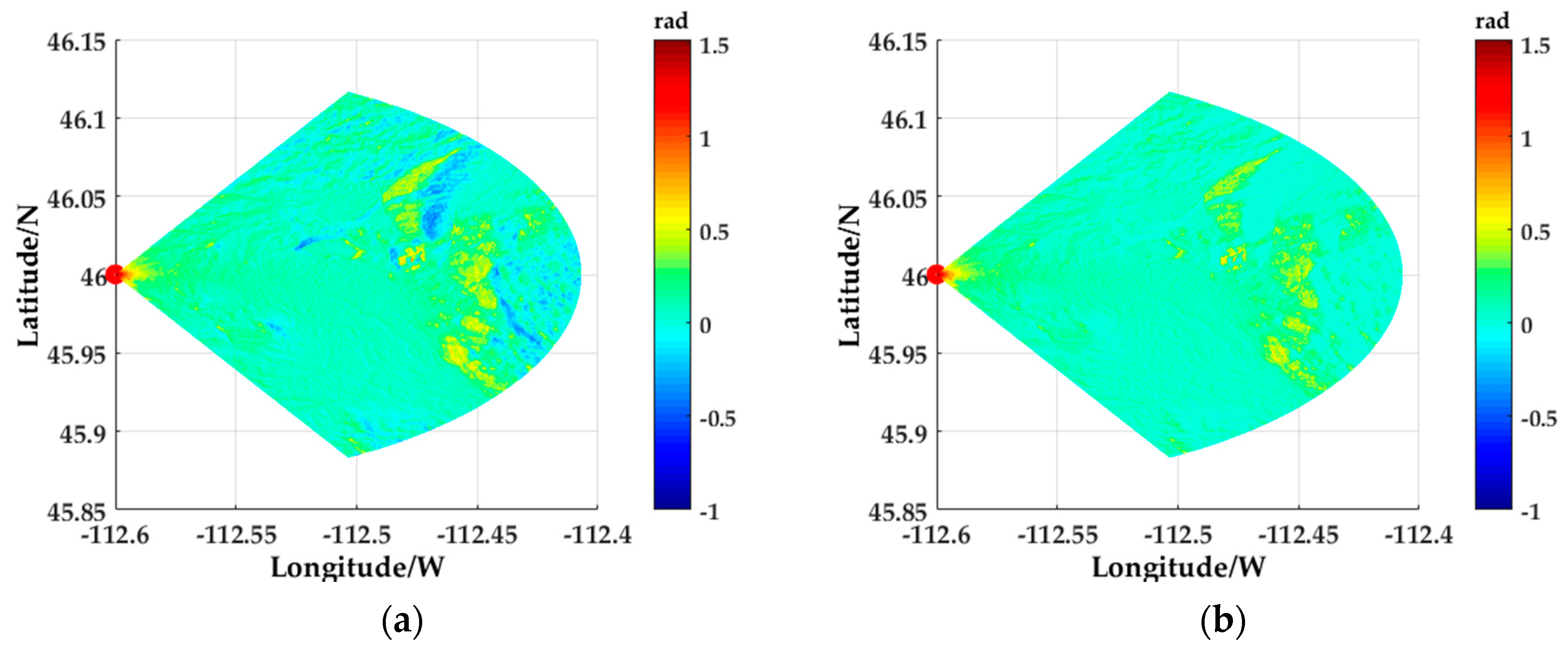
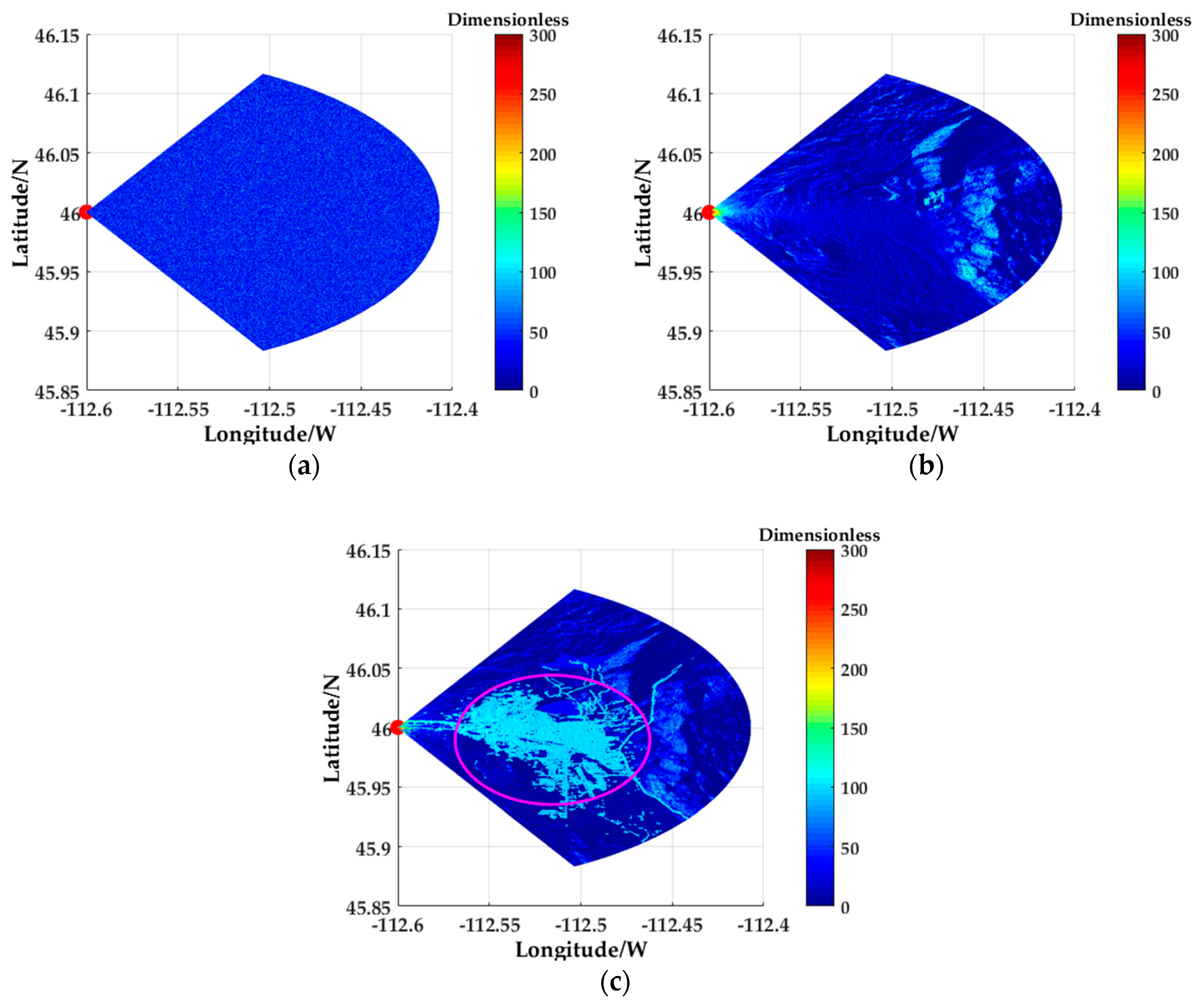

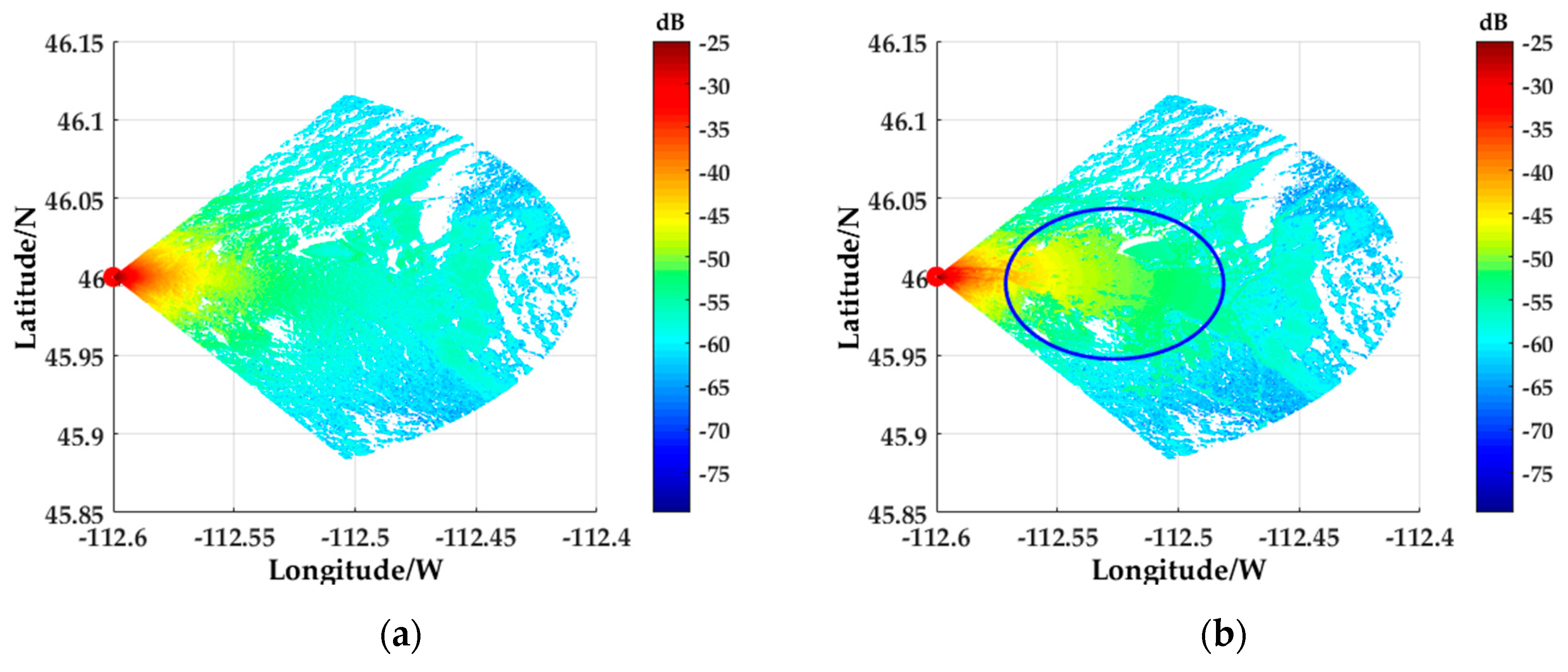
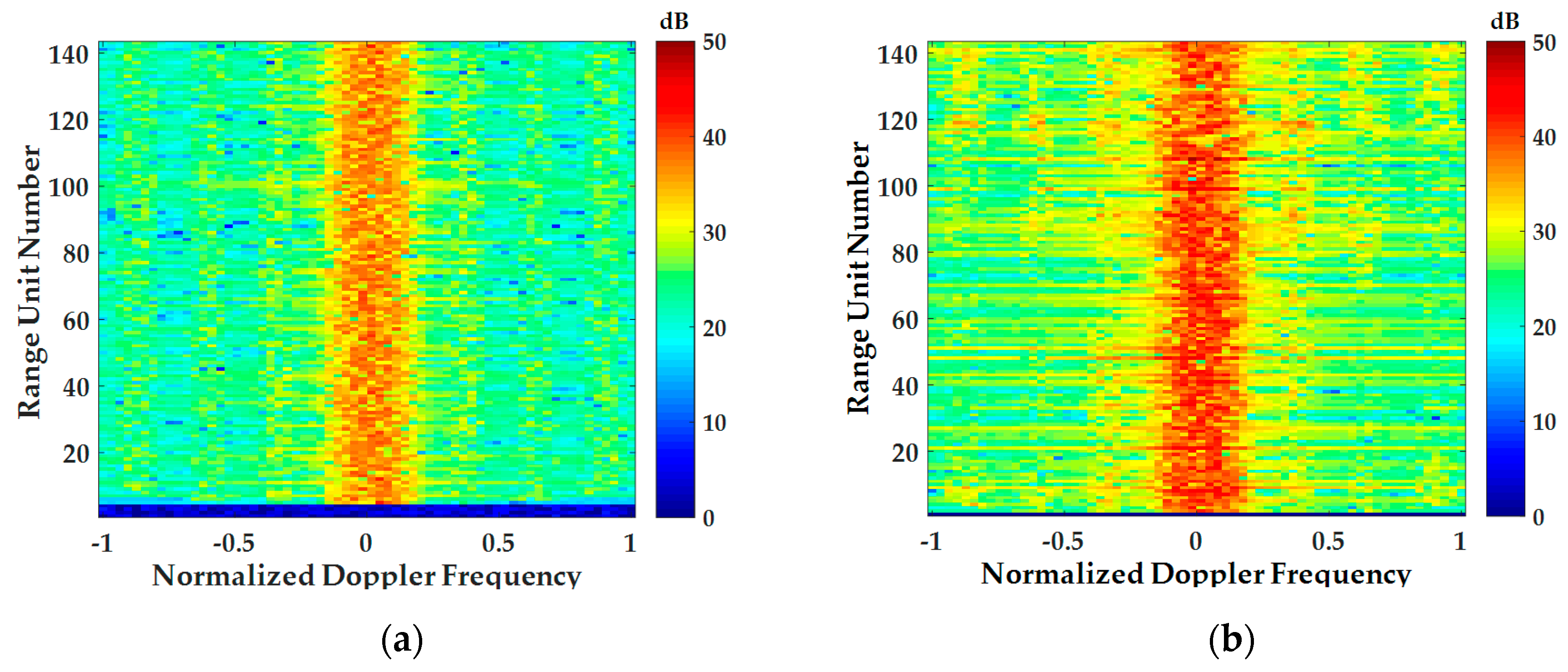
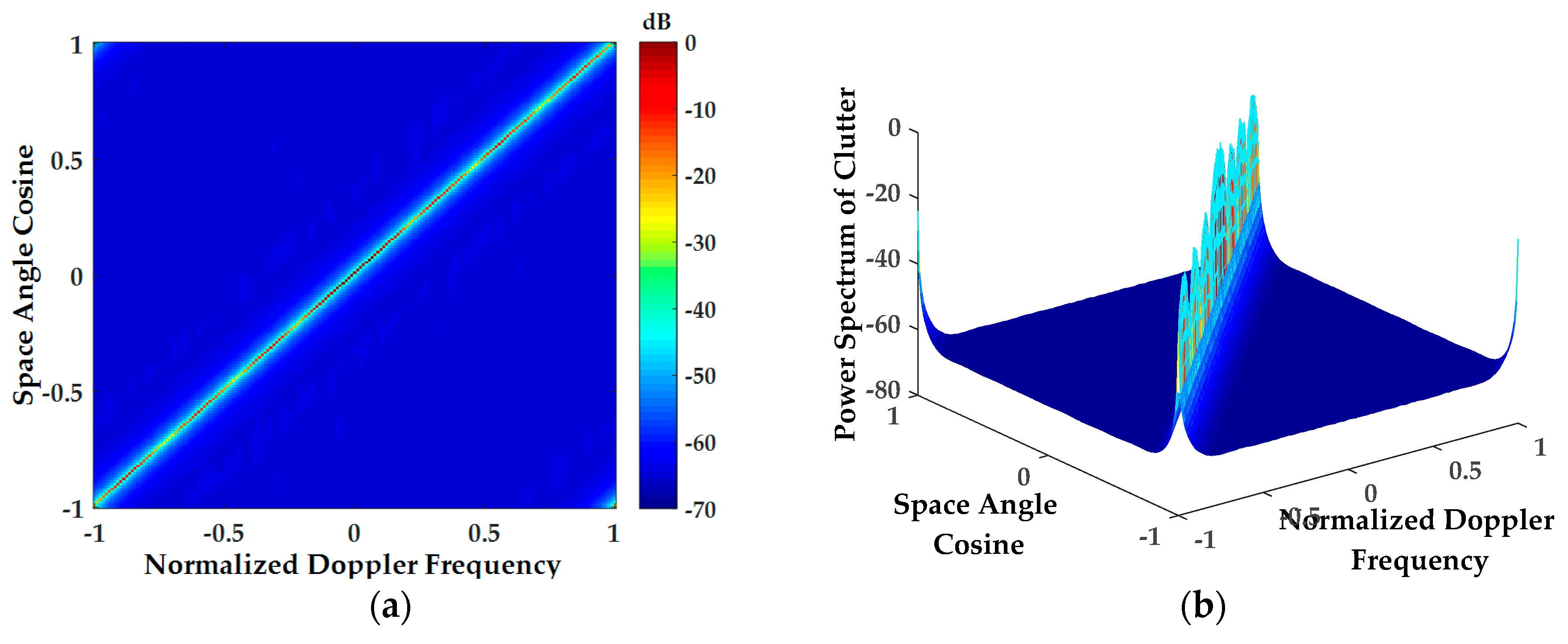
| Code | Landform Types | ||||
|---|---|---|---|---|---|
| Farmland | 1 | 0.004 | 0.2 | ||
| Hills | 1 | 0.0126 | 0.4 | ||
| Mountain | 1 | 0.04 | 0.5 | ||
| Mud | 1 | 0.001945 | 0.155 | ||
| Snow Land | 1 | 0.00263 | 0.17 | ||
| Grassland | 1 | 0.00572 | 0.24 | ||
| Crop Land | 1 | 0.00744 | 0.28 | ||
| Forest | 1 | 0.00916 | 0.32 | ||
| Bare Land | 1 | 0.01088 | 0.36 |
| Aircraft Height (m) | 600 | Element Number | 8 |
| Aircraft Speed (m/s) | 87.5 | Sample Pulse Number | 64 |
| Radar Wavelength (m) | 0.05 | Main Lobe Direction (°) | (90, 15) |
| Pulse Repetition Frequency (Hz) | 7000 | CNR (dB) | 50 |
© 2018 by the authors. Licensee MDPI, Basel, Switzerland. This article is an open access article distributed under the terms and conditions of the Creative Commons Attribution (CC BY) license (http://creativecommons.org/licenses/by/4.0/).
Share and Cite
Li, H.; Wang, J.; Fan, Y.; Han, J. High-Fidelity Inhomogeneous Ground Clutter Simulation of Airborne Phased Array PD Radar Aided by Digital Elevation Model and Digital Land Classification Data. Sensors 2018, 18, 2925. https://doi.org/10.3390/s18092925
Li H, Wang J, Fan Y, Han J. High-Fidelity Inhomogeneous Ground Clutter Simulation of Airborne Phased Array PD Radar Aided by Digital Elevation Model and Digital Land Classification Data. Sensors. 2018; 18(9):2925. https://doi.org/10.3390/s18092925
Chicago/Turabian StyleLi, Hai, Jie Wang, Yi Fan, and Jungong Han. 2018. "High-Fidelity Inhomogeneous Ground Clutter Simulation of Airborne Phased Array PD Radar Aided by Digital Elevation Model and Digital Land Classification Data" Sensors 18, no. 9: 2925. https://doi.org/10.3390/s18092925




